August 14, 2025
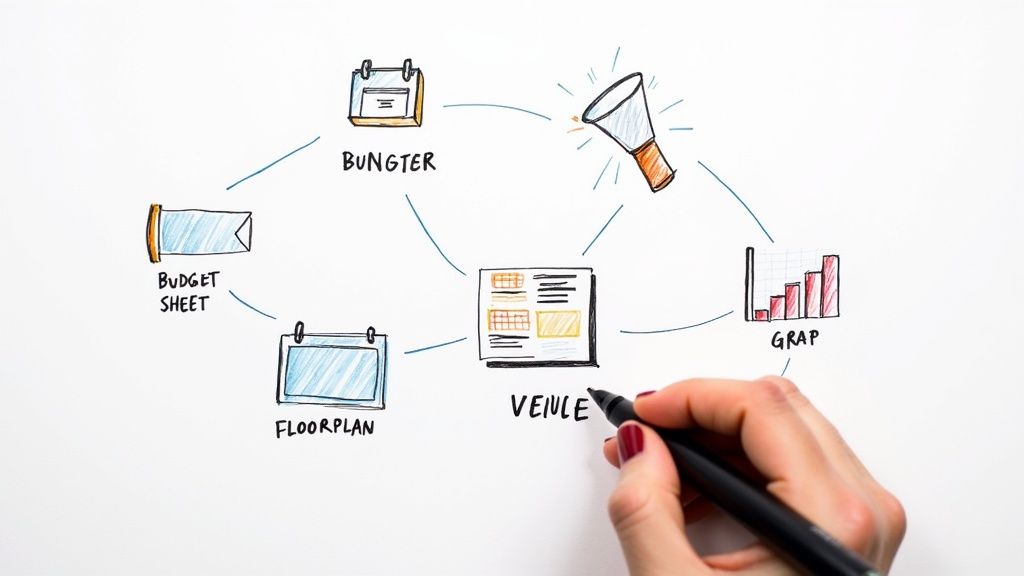
Before you even think about venue tours or catering samples, the real work of planning a corporate event begins. It’s not about the logistics—not yet, anyway. It’s about laying a rock-solid foundation. A successful event is built on a clear vision and a well-defined purpose that connects directly to real business goals. Get this wrong, and even the most glamorous event can miss the mark entirely.
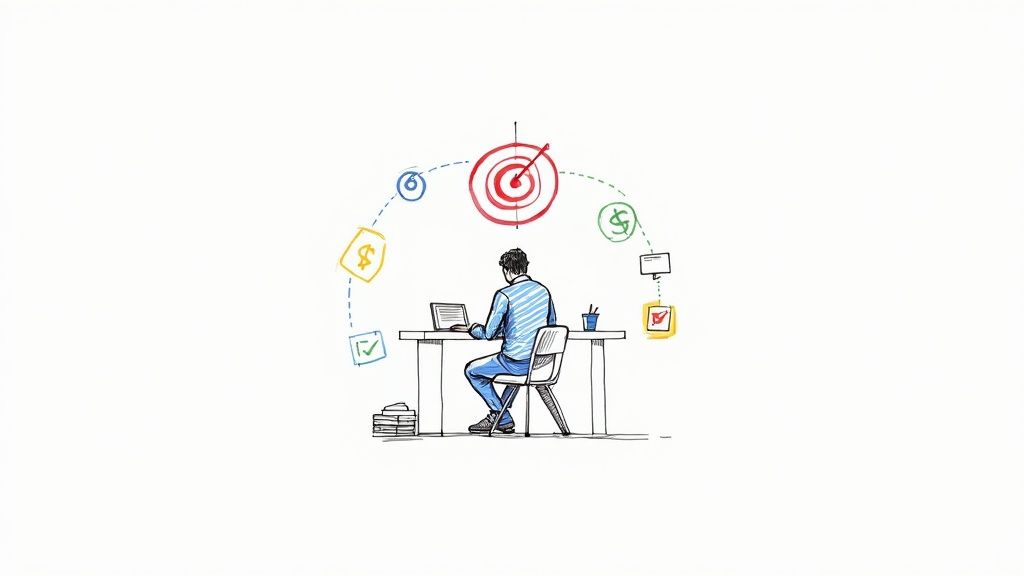
This first phase is all about asking the big "why" questions. What are we actually trying to achieve here? Is the goal to drum up new business? Celebrate our team and build loyalty? Or are we making a huge splash with a new product launch? Your answers to these questions will become your North Star, guiding every single decision you make from this point forward.
Every single event, from an internal workshop to a massive industry conference, needs sharp, measurable goals. Vague ambitions like "improving company culture" just won't cut it. You have to translate that feeling into something you can actually track.
For example, "boosting team morale" is a great sentiment, but a better objective is aiming for a 20% increase in positive responses on a post-event employee satisfaction survey. A product launch isn't just about creating "buzz"—its success could be defined by landing coverage in 10 key industry publications or generating 150 qualified leads for the sales team.
Here are a few examples of what strong, clear objectives look like in practice:
With your objectives locked in, it’s time to talk money. One of the most common rookie mistakes I see is plucking a budget figure out of thin air. Your budget isn't just a number; it's your financial roadmap. A detailed one keeps you on track, prevents nasty surprises, and ensures you're putting money where it will make the biggest impact.
Start by brainstorming every single potential cost, no matter how small. Go beyond the big-ticket items like the venue and food. What about A/V tech, marketing promotions, speaker fees, on-site staff, and security? And don't forget the contingency fund.
Pro Tip: Always, always set aside 10-15% of your total budget for a contingency fund. This isn't just "nice to have"—it's your safety net. It's what will save you when you need last-minute equipment, have to pay staff overtime, or face an unexpected rush printing charge.
This level of financial planning is more critical than ever. The corporate event industry is booming, projected to grow from about $736.8 billion in 2021 to a massive $2.5 trillion by 2035. With 74% of event marketers planning to increase their event spend, a meticulously planned budget is the only way to ensure your investment pays off.
To help you get started, here’s a look at how a budget might break down.
This table offers a practical framework showing typical spending percentages to guide your corporate event budget. While every event's needs will differ, this gives you a solid starting point for allocating funds effectively.
Remember, this is a guide, not a rigid rule. A tech-heavy conference might spend more on A/V, while a gala might allocate more to F&B and entertainment. Adjust these percentages to align with your specific event objectives.
Building out this foundational strategy is the first step. To keep learning, you can find more essential corporate event planning tips that will help you round out your knowledge and prepare you for everything that comes next.
Let's be honest: a great event is never a one-person show. It's a carefully orchestrated performance, and with your core objectives and budget set, it's time to assemble your cast and crew. This means building the right internal team and creating a master timeline that will guide you all the way to showtime.
Think of your internal team less like a formal committee and more like a special ops unit. Each member needs to own a critical function. And a word of advice from experience: don't just assign roles based on job titles. Focus on skills and, just as importantly, bandwidth. Your best project manager might be in a department completely unrelated to marketing, but their knack for organization is exactly what you need.
Every successful event I've ever run relied on a handful of key players to make sure every base was covered. While the exact setup will change with your event's size, these roles are almost always fundamental.
You'll want to find people to fill these crucial positions:
Once you have your team, get them on a shared project management tool immediately. Having the right tech is non-negotiable for staying efficient and aligned. It's worth taking the time to explore the top event management software features to find what works best for your crew.
Here's a pro tip that will save you a world of stress: work backward. Always start with your event date and map out every single milestone in reverse. This method, often called a reverse timeline or backdating, is your secret weapon against last-minute chaos. It breaks a massive project down into a series of calm, manageable deadlines.
For instance, if your event is on December 1st, your timeline would plot key dates moving backward. You'd set deadlines for when final vendor payments are due, when speaker confirmations are locked in, and when that first promotional email absolutely has to go out. Our comprehensive guide to event management planning dives much deeper into how to build these critical roadmaps.
A reverse timeline prevents last-minute panic. It forces you to address long-lead items—like booking a popular venue 9-12 months out—well before they become a crisis. This foresight is what separates professional planners from amateurs.
This flow chart shows the basic stages for bringing on your external partners, from the initial research all the way to signing on the dotted line.
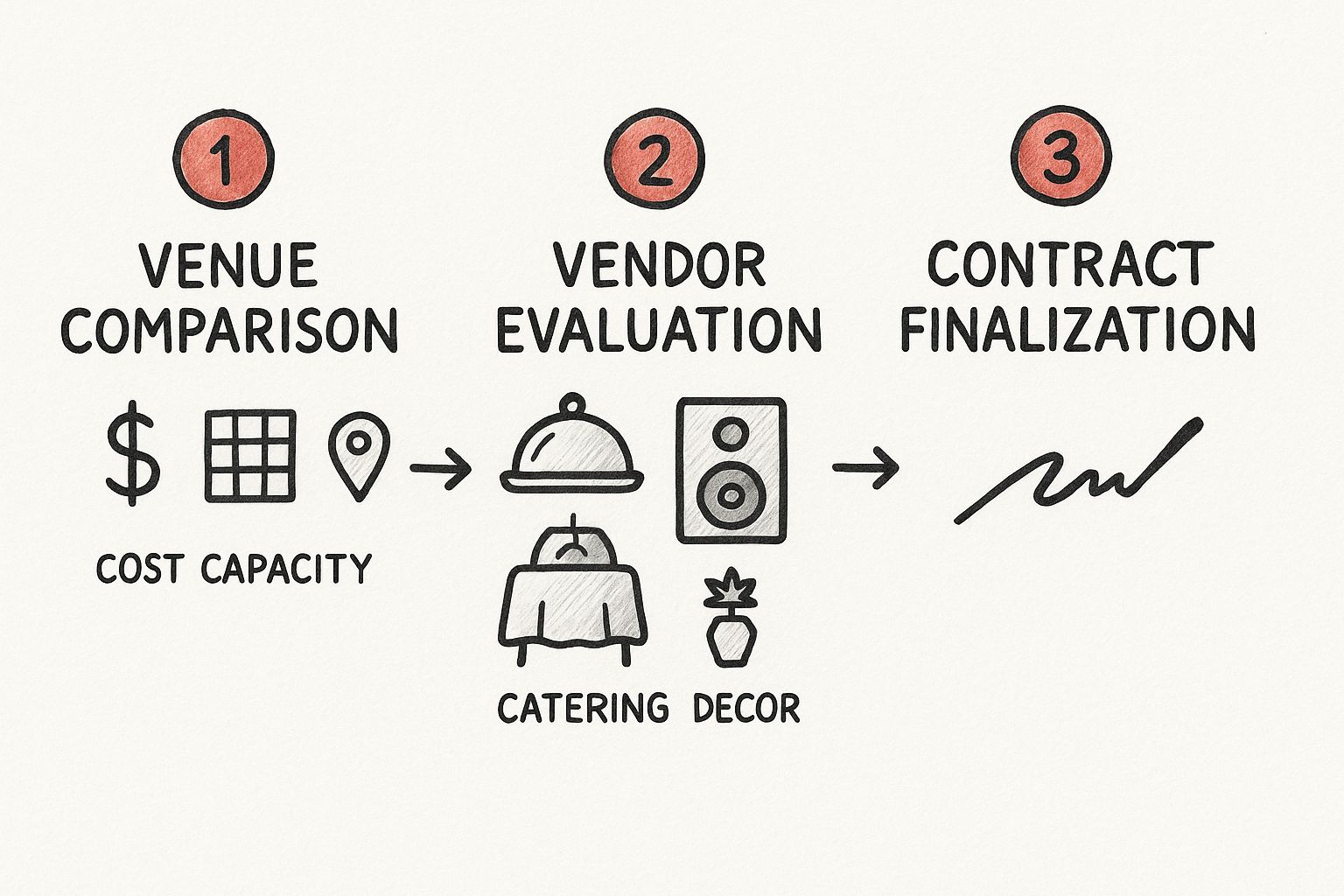
As you can see, it's a logical progression. You have to evaluate things like cost, capacity, and overall quality before you start committing to contracts.
Your internal squad can't do it all, which is where your external partners come in. You'll need to team up with venues, caterers, and AV providers. Treat this process exactly like a job interview, because that's what it is. You’re hiring a company to execute a piece of your vision.
Don't just ask about the price tag. You need to dig deeper with questions that reveal their real-world experience and how they handle pressure.
Key Questions to Ask Potential Vendors:
Asking these kinds of pointed questions helps you see past a simple price quote and truly evaluate a vendor's value and reliability. This careful vetting process is what makes the difference between an event that feels effortless and one that's a constant firefight.
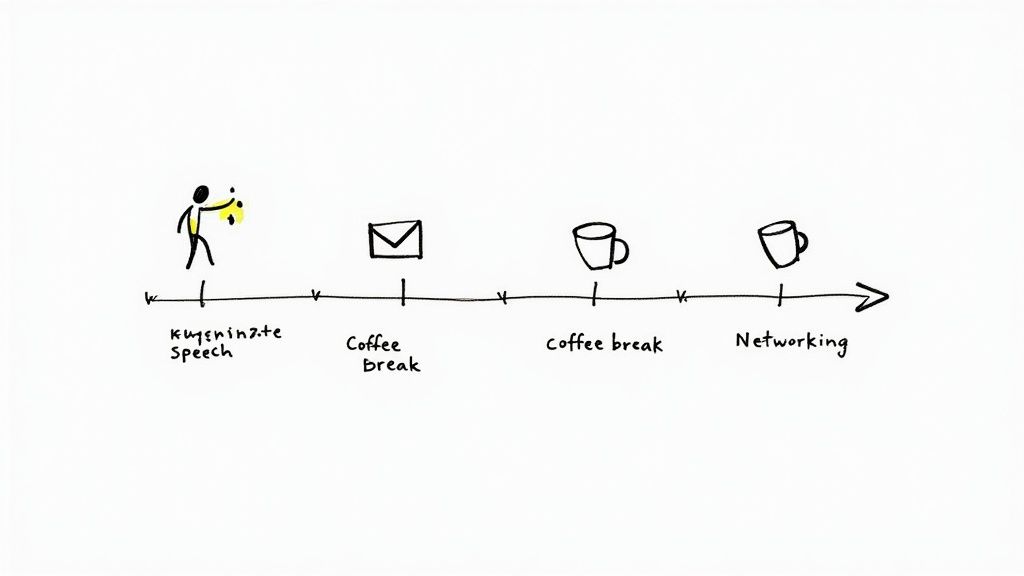
With your core strategy and team locked in, it’s time to shift your focus from the "why" to the "how." This is where the magic happens. The real difference between a forgettable corporate event and one people talk about for months is the attendee journey. You're essentially choreographing an experience that feels valuable, seamless, and genuinely engaging from the moment they register to the final farewell.
It all starts with a strong, central theme. I’m not talking about cheesy decorations, but a unifying idea that weaves through your content, messaging, and overall atmosphere. Think of it as the creative filter for every decision. A sales kickoff with a "Peak Performance" theme can shape everything from session names to team-building activities. For a leadership summit, a theme like "Architects of the Future" immediately sets a collaborative, forward-thinking tone.
Your agenda is the narrative of your event. A poorly paced one will drain the energy right out of the room, but a thoughtfully designed schedule keeps people hooked and looking forward to what’s next. The secret is finding that sweet spot between structured content and unstructured connection.
One of the biggest mistakes I see planners make is cramming too much into the day. People need brain breaks! More importantly, they need time to talk to each other. After all, networking is consistently a top reason people attend events. If you don't build in time for it, you're failing to deliver on a key promise.
Your agenda should tell a story with a clear beginning, middle, and end. Kick things off with a high-energy opening keynote to set the tone, build momentum with insightful breakout sessions, and wrap it all up with an inspiring call to action or a fun closing reception.
When mapping it out, I like to think in dedicated time blocks:
This approach respects your attendees' energy and attention, making the whole experience feel less like a marathon and more like a valuable day out of the office.
The right speaker can completely transform your event. When you’re vetting talent, look past the big names and focus on relevance. The best speakers are the ones who can truly connect with your specific audience and deliver insights that align with your event goals. Always, always ask for recent, unedited speaking clips—not just a flashy sizzle reel—to get a real sense of their stage presence.
But engagement is more than just a great speaker. You have to actively build it into the fabric of your event using technology. Don’t just hope people participate; give them easy ways to do it.
Finally, think about the little details that get people talking. Instead of a standard buffet, why not hire a few local food trucks or set up themed food stations? These unique touches become natural conversation starters and show you’ve put thought into every aspect of their experience. At the end of the day, your goal is simple: make every single person feel like their time was incredibly well spent.
Let's be honest: an empty room is every event planner's worst nightmare. You can nail the strategy, book the perfect venue, and design an incredible experience, but none of that matters if the right people don't show up. This is where smart, multi-channel marketing comes in. It’s not just about blasting emails—it’s about creating a real sense of excitement and urgency.
The first thing I always do is get crystal clear on who I'm trying to reach. Don't just settle for "clients" or "employees." Go deeper and build out a detailed attendee persona. What are their actual job titles? What keeps them up at night professionally? Where do they hang out online? Answering these questions lets you craft messages that speak directly to them, hitting on their pain points and motivations.
Once you know your audience inside and out, you can start building your marketing engine. Think of it as a central hub with many spokes, and at the center of it all is your event landing page. This page is your primary sales tool, not just a place to collect registrations.
Your landing page has one job: to convert visitors into attendees. It needs to scream "what's in it for me?" from the moment someone lands on it.
With your landing page live, it's time to drive traffic. For most corporate events, a segmented email campaign will be your workhorse. The key is segmentation. Don't send the same generic blast to your entire list. For instance, you’d send a C-suite executive an email focused on high-level strategy, while a junior manager gets a message highlighting hands-on workshops. A well-executed email strategy is genuinely one of the most effective ways to fill seats.
It's no surprise that boosting attendance is a top concern for 52% of event planners. We're all feeling that pressure. Thankfully, technology gives us an edge. A staggering 91% of planners see a positive ROI from mobile event apps, and around 70% of us are now using AI to personalize marketing. You can see more data on how tech is changing the game and discover event industry statistics on remo.co.
Social media is where you turn up the volume. Post teaser content, share behind-the-scenes photos of the planning, and drop short video interviews with your speakers. Create a unique event hashtag and get everyone—your team, your speakers, your sponsors—to use it. This creates an authentic buzz that you just can't buy. For high-stakes events, I highly recommend targeted ads on platforms like LinkedIn to reach your exact attendee persona based on their job title, industry, and even company size.
The marketing doesn't stop when you get a registration. In fact, this is a critical phase. The time between someone signing up and the actual event day is your golden opportunity to build anticipation and drastically reduce no-shows.
Keep your confirmed attendees in the loop with a steady stream of valuable info:
Of course, a bigger marketing budget helps you do more. Securing financial backing can make all the difference. If that's an area you need help with, our guide on how to obtain sponsorships from corporations is packed with actionable advice. By keeping your attendees informed and excited, you ensure they don't just show up—they arrive ready and eager to participate.
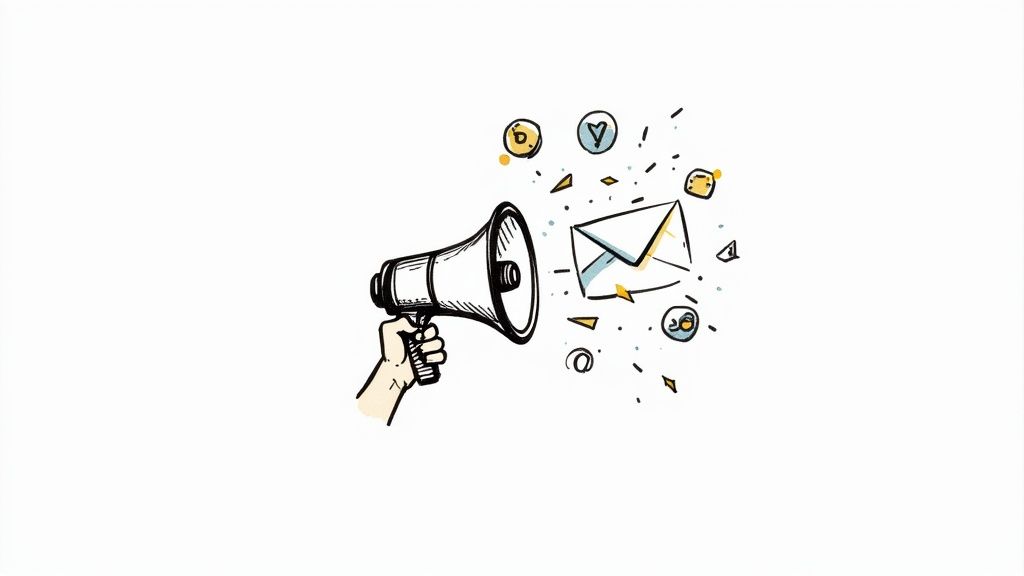
This is it. Event day is when all the spreadsheets, phone calls, and late-night planning sessions pay off. Your job now shifts from planner to conductor, and the goal is to make the entire experience feel effortless for your guests, even if things get a little hectic behind the scenes. A calm, decisive presence is your superpower today.
Long before the first guest walks through the door, you need to hold a pre-event huddle. I can't stress this enough—this meeting is non-negotiable. Get your entire on-site crew together, from the registration team to the AV techs and catering leads, for one final briefing.
We're not just reading the schedule aloud. This is about confirming who owns what and how everyone will communicate. A simple trick I've used for years is creating a one-page "day-of" contact sheet. It has every key person's name, role, and cell number. When you urgently need the lighting tech, this little piece of paper is an absolute lifesaver.
Right after the huddle, it’s time for a final, meticulous walkthrough of the venue. This isn’t just a casual glance; you're on a mission with your checklist in hand to inspect every single detail.
Is the signage pointing the right way? Is the Wi-Fi password clearly displayed? Are the registration desks stocked with badges, lanyards, and pens? I always physically check the AV setup—mics, clickers, presentation—and confirm that every vendor's station matches what's in their contract. This is your last chance to spot and fix a small hiccup before it becomes a big problem for an attendee.
This is also the perfect moment to reinforce roles so there's zero confusion.
When everyone knows their exact job, your team can act with confidence and you're free to focus on the bigger picture.
The check-in process is your event's handshake. A smooth, quick entry sets a positive tone for the whole day, while a long, confusing line does the exact opposite. Your goal here is efficiency with a human touch.
A study by event experts reveals a simple truth "Being calm is key. Even if behind the scenes you’re frazzled and worried, always showing a calm demeanor keeps everyone else around you more level-headed and calm as well." This is never more true than when you have a hundred people arriving at once.
My rule of thumb is to overstaff the registration desk for that first 30-60 minute arrival rush. If you’re using QR codes for digital check-in, test the Wi-Fi signal in that specific area and make sure your staff's scanners are working perfectly. Simple alphabetical signs (A-F, G-L, etc.) can also do wonders to prevent bottlenecks and get people moving.
No matter how perfectly you plan, something will go sideways. It’s a law of events. The mark of an experienced planner is not avoiding problems, but handling them with grace and having a solution ready.
Common Event-Day Challenges & Solutions
At the end of the day, a successful on-site experience boils down to solid preparation and clear, open lines of communication. By anticipating challenges and empowering your team, you can tackle any curveball with confidence and ensure your corporate event is remembered for all the right reasons.
The event might be over, but your most important work is just beginning. Once the last guest leaves and the cleanup crew moves in, it's time to shift gears from execution to analysis. This final phase is all about proving the event's value and mining for the gold—the data that will make your next event even better.
This isn't just about confirming that the event felt successful. It's about tying every outcome directly back to the specific, measurable goals you set on day one. Did you actually accomplish what you set out to do? The numbers will tell the story.
Your first move should be to tap into your most valuable asset: your attendees. The trick is to design post-event surveys that deliver honest, nitty-gritty feedback, not just fluff. A survey full of generic "Did you have a good time?" questions is a wasted opportunity.
Instead, you need to ask targeted questions that really dig into the specifics of their experience.
Getting this right is everything. You're searching for the "why" behind the scores. This is the feedback that tells you whether to rebook a keynote speaker, rethink the agenda's flow, or invest in better registration tech.
I've learned this the hard way: don't wait to send your survey. Get it into their inboxes within 24 hours of the event closing. Their thoughts are still fresh, and you'll see a much, much higher response rate.
With the survey data rolling in, it's time to crunch the numbers and compare your Key Performance Indicators (KPIs) against those initial goals. This is where you calculate the real return on investment. If you want to prove your event's success and lock in next year's budget, knowing your event ROI metrics is absolutely non-negotiable.
What you track will depend entirely on what you set out to achieve in the first place.
This data-driven debrief isn't just a report card; it's your strategic blueprint for the future. For a much deeper look at the formulas and strategies, our guide on measuring event ROI will walk you through the whole process.
Finally, don't let the buzz die down. Your relationship with attendees shouldn't end the moment they submit a survey. Smart, strategic follow-up can extend your event's value for weeks, if not months.
A personalized thank-you email is a nice touch, but you need to go further. Send out a content recap packed with links to presentation slides, recordings of the best sessions, and a photo gallery. This gives them something tangible and reinforces what they learned.
For any event with a sales component, this is the most critical handoff. Make sure the sales team gets a full briefing on who attended, which sessions they went to, or what products they showed interest in. This context allows for a warm, relevant follow-up conversation that starts with their event experience, not a cold pitch. This kind of thoughtful engagement shows you value their time and sets the stage for your next incredible corporate event.
When you're deep in the trenches of planning a corporate event, a few key questions always seem to pop up. Let's tackle some of the most common ones with practical advice pulled from years of experience.
Honestly, this completely depends on the size and complexity of your event. There’s no single right answer, but there are some solid rules of thumb.
If you’re organizing a smaller, internal workshop for under 50 people, you can generally pull it off with a 1- to 3-month lead time. This gives you enough runway to get everything in order without too much stress.
But for the big stuff—we’re talking conferences, elaborate galas, or any event with over 100 guests—you need to think much bigger. I always recommend starting the planning process a good 6 to 12 months in advance. That might sound like a lot, but top-tier venues and in-demand vendors get snapped up early. This longer timeframe also gives your marketing efforts the space they need to build real momentum.
I’ve seen a few common tripwires over the years. The most frequent misstep is diving in without a clear, realistic budget or, just as damaging, having no defined goals. What does success actually look like for this event? If you can't answer that, you're flying blind.
Other classic blunders include spotty communication with vendors—which is a recipe for day-of chaos—and completely skipping any kind of post-event follow-up. A well-thought-out project timeline and a clear communication plan are your best friends here.
The one mistake I see that causes the most panic? Not having a solid contingency plan. What happens if your keynote speaker gets sick? What if a sudden storm makes your outdoor venue unusable? Always have a Plan B (and maybe a Plan C) for your most critical event components. It's the ultimate stress-reducer.
Ready to manage your next event with a powerful, all-in-one platform? GroupOS integrates ticketing, memberships, content delivery, and communication seamlessly. Start your free trial today and see how GroupOS can elevate your events.


